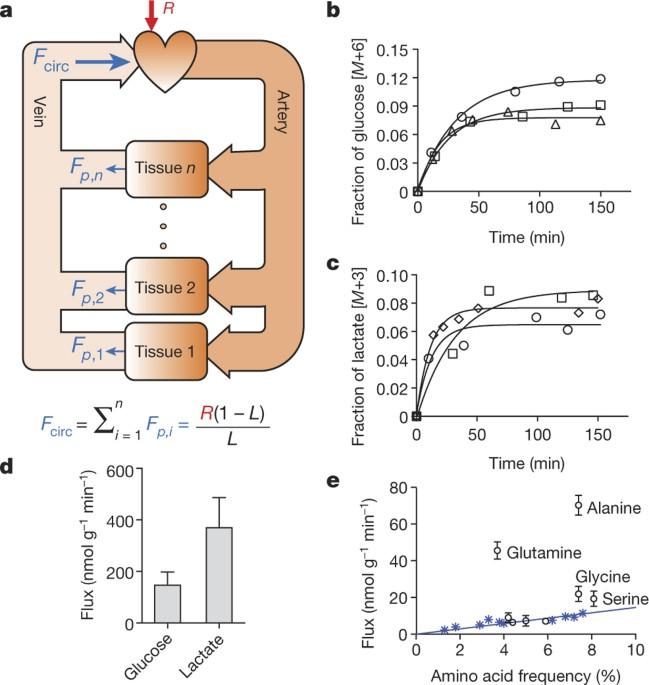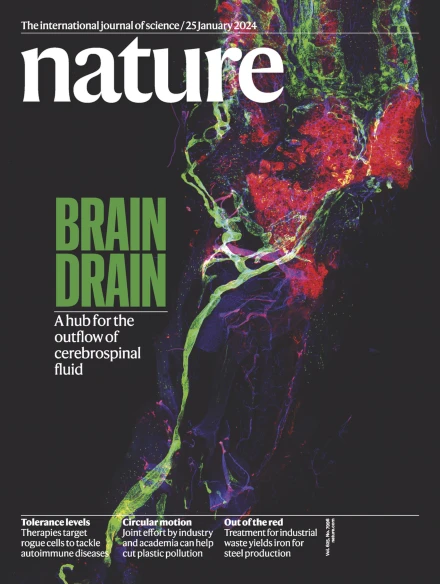葡萄糖通过循环乳酸为 TCA 循环提供能量
IF 48.5
1区 综合性期刊
Q1 MULTIDISCIPLINARY SCIENCES
引用次数: 1008
摘要
小鼠代谢通量分析表明,乳酸通常是正常组织和肿瘤微环境中三羧酸循环的主要碳源。葡萄糖被认为是三羧酸循环(又称柠檬酸循环)的主要燃料来源,三羧酸循环产生重要的代谢产物和能量。现在,盛辉等人对小鼠进行了全身代谢物分析。他们发现,循环中的乳酸而不是葡萄糖是碳的主要来源,因此在进食和禁食的小鼠体内都是 TCA 代谢的燃料。此外,他们还发现肿瘤组织也是如此。哺乳动物组织的燃料来自循环营养物质,包括葡萄糖、氨基酸和各种中间代谢产物。在有氧条件下,一般认为葡萄糖会被组织通过三羧酸循环(TCA 循环)完全燃烧,生成二氧化碳。另外,葡萄糖也可通过糖酵解进行无氧分解为乳酸,乳酸本身也是组织1 和肿瘤2,3,4,5 的潜在营养物质。循环中的乳酸或其他代谢中间产物作为燃料的定量相关性仍不清楚。在这里,我们系统地研究了小鼠体内循环代谢产物的通量,发现乳酸盐可以作为 TCA 循环的主要碳源,从而成为能量来源。通过静脉注射 13C 标记的营养物质发现,以摩尔为基础,乳酸的循环周转通量是所有代谢物中最高的,在进食的小鼠中是葡萄糖的 1.1 倍,在空腹的小鼠中是葡萄糖的 2.5 倍;乳酸主要由葡萄糖制造,但也可由其他来源制造。在喂养和禁食的小鼠中,13C-乳酸盐广泛标记所有组织中的 TCA 循环中间产物。定量分析显示,在禁食状态下,除大脑外,所有组织中葡萄糖对组织 TCA 代谢的贡献主要是间接的(通过循环乳酸盐)。在禁食小鼠的基因工程肺癌和胰腺癌肿瘤中,循环乳酸对 TCA 循环中间产物的贡献超过葡萄糖,在胰腺癌中,谷氨酰胺的贡献大于乳酸。因此,糖酵解和 TCA 循环在乳酸水平上是不耦合的,而乳酸是大多数组织和肿瘤中主要的循环 TCA 底物。本文章由计算机程序翻译,如有差异,请以英文原文为准。

Glucose feeds the TCA cycle via circulating lactate
Metabolic flux analysis in mice reveals that lactate often acts as the primary carbon source for the tricarboxylic acid cycle both in normal tissues and in tumour microenvironments. Glucose is thought to be the primary source of fuel for the tricarboxylic acid (TCA) cycle, also known as the citric acid cycle, which produces important metabolites and energy. Sheng Hui et al. now perform whole-body metabolite analysis in mice. They find that circulating lactate rather than glucose can be a major source of carbon and hence fuel for TCA metabolism in both fed and fasting mice. They furthermore show this to be the case in tumour tissue. Mammalian tissues are fuelled by circulating nutrients, including glucose, amino acids, and various intermediary metabolites. Under aerobic conditions, glucose is generally assumed to be burned fully by tissues via the tricarboxylic acid cycle (TCA cycle) to carbon dioxide. Alternatively, glucose can be catabolized anaerobically via glycolysis to lactate, which is itself also a potential nutrient for tissues1 and tumours2,3,4,5. The quantitative relevance of circulating lactate or other metabolic intermediates as fuels remains unclear. Here we systematically examine the fluxes of circulating metabolites in mice, and find that lactate can be a primary source of carbon for the TCA cycle and thus of energy. Intravenous infusions of 13C-labelled nutrients reveal that, on a molar basis, the circulatory turnover flux of lactate is the highest of all metabolites and exceeds that of glucose by 1.1-fold in fed mice and 2.5-fold in fasting mice; lactate is made primarily from glucose but also from other sources. In both fed and fasted mice, 13C-lactate extensively labels TCA cycle intermediates in all tissues. Quantitative analysis reveals that during the fasted state, the contribution of glucose to tissue TCA metabolism is primarily indirect (via circulating lactate) in all tissues except the brain. In genetically engineered lung and pancreatic cancer tumours in fasted mice, the contribution of circulating lactate to TCA cycle intermediates exceeds that of glucose, with glutamine making a larger contribution than lactate in pancreatic cancer. Thus, glycolysis and the TCA cycle are uncoupled at the level of lactate, which is a primary circulating TCA substrate in most tissues and tumours.
求助全文
通过发布文献求助,成功后即可免费获取论文全文。
去求助
来源期刊

Nature
综合性期刊-综合性期刊
CiteScore
90.00
自引率
1.20%
发文量
3652
审稿时长
3 months
期刊介绍:
Nature is a prestigious international journal that publishes peer-reviewed research in various scientific and technological fields. The selection of articles is based on criteria such as originality, importance, interdisciplinary relevance, timeliness, accessibility, elegance, and surprising conclusions. In addition to showcasing significant scientific advances, Nature delivers rapid, authoritative, insightful news, and interpretation of current and upcoming trends impacting science, scientists, and the broader public. The journal serves a dual purpose: firstly, to promptly share noteworthy scientific advances and foster discussions among scientists, and secondly, to ensure the swift dissemination of scientific results globally, emphasizing their significance for knowledge, culture, and daily life.
 求助内容:
求助内容: 应助结果提醒方式:
应助结果提醒方式:


